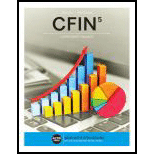
Concept explainers
The company FC will pay its first dividend of $2, at the end of Year 2. From the third year it is expected to grow at a rate of 5%. Required
Non-Constant Dividend Growth Model
Non-constant growth model assumes that the company pay dividends based on its growth stage. According to the model, different amounts of dividends are paid in the initial years and then at some point of time they enter a phase with constant dividend growth model. Therefore, for the period in which the dividends paid are varying,
Stock price for non-constant growth model can be computed as follows:
Step 1
Find dividends for the non-constant growth period and discount them to the present value
Step 2
Compute the dividend at the start of the constant growth period and then using constant growth model, calculate the horizontal value of the stock at the end of the non-constant growth period.
Step 3
Find the present value of this horizontal stock price
Step 4
Add the present value of all the dividends and the present value of the horizontal price, to determine the current stock value
Want to see the full answer?
Check out a sample textbook solution
Chapter 7 Solutions
CFIN (with Online, 1 term (6 months) Printed Access Card) (New, Engaging Titles from 4LTR Press)
- If a company has total debt of $120,000 and total equity of $80,000, what is the debt-to-equity ratio?arrow_forwardIf you invest $15,000 in a project that generates $5,000 per year, how long will it take to recover your investment? Helparrow_forwardIf you receive $1,000 at the end of each year for 3 years, with a discount rate of 10%, what is the NPV? Helparrow_forward
- If you receive $1,000 at the end of each year for 3 years, with a discount rate of 10%, what is the NPV?arrow_forwardCould you please help explain what an efficient market hypothesis (EMH), behavioral finance theory, and market microstructure theory? What is the description of research design in the capital market?arrow_forwardNo ai only expert correctly answer...??arrow_forward
 EBK CONTEMPORARY FINANCIAL MANAGEMENTFinanceISBN:9781337514835Author:MOYERPublisher:CENGAGE LEARNING - CONSIGNMENT
EBK CONTEMPORARY FINANCIAL MANAGEMENTFinanceISBN:9781337514835Author:MOYERPublisher:CENGAGE LEARNING - CONSIGNMENT Intermediate Financial Management (MindTap Course...FinanceISBN:9781337395083Author:Eugene F. Brigham, Phillip R. DavesPublisher:Cengage Learning
Intermediate Financial Management (MindTap Course...FinanceISBN:9781337395083Author:Eugene F. Brigham, Phillip R. DavesPublisher:Cengage Learning

